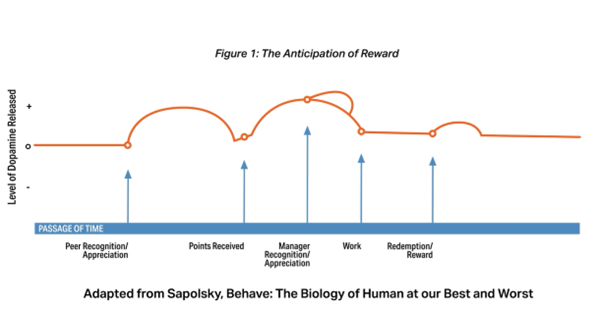The right reward
Cash is king. We’ve all heard that phrase. A variety of studies have shown that when asked, most people will say “give me the cash” in exchange for motivating their behaviour – but when it comes to actually doing that behaviour, more people are motivated by non-cash rewards. This is a clear example of Preference Reversal - Saying one thing and doing another.
Scroll Down
A study conducted by Incentive Research Foundation, found although with annual awards cash bonuses were almost universally a top pick of how employees wanted to be rewarded. Yet, receiving a cash bonus was ranked sixth when rewards were correlated to job satisfaction and for motivation to do best work.
Research conducted by BI WORLDWIDE found that people perform at a higher level when the awards are focused on wants, like experiences and merchandise, versus cash.
"Money, as it turns out, is very often the most expensive way to motivate people."
Dan Ariely, Predictably Irrational
https://www.biworldwide.com.au/research/blog/why-cash-incentives-are-not-a-winner/
It is accepted in the behavioural science community that non-cash rewards are a more effective motivator than cash. But why? Well, rewards that are tangible and experience-based, stimulate visualisation and evoke human emotions. This is known as hedonic rewards.
Ran Kivetz, PhD, of Columbia University, indicates that when awards are made in cash, the mind of the receiver becomes calculative in nature. In other words, rewards that are positioned in specific dollar values tend to be seen as a deal by the recipient: “If I do this, it’s worth $X to me.” Most recipients won’t consider the reward a “deal” when the dollar value is not explicit. With non-monetary, tangible rewards, most people ask themselves, “Do I want this? What do I have to do to get it?”
Cash is very private and transactional in nature. When you think about it, people don’t commonly tell friends or colleagues about their cash rewards. They are more likely to share their tangible rewards, such as a watch or golf clubs. Just by sharing, the reward experience is enhanced. This is known as sociability - the desire to talk about the reward with others.
There is also a re-consumption element to hedonic rewards. Every time you use or see your tangible reward, the brain remembers the reasons for earning the reward (acts as a reinforcement mechanism in the brain – stored as long-term memory). That reminder gives you a sense of achievement and fulfilment. Cash is forgotten about as soon as you spend it.
On top of that, people are more likely to use their cash rewards on everyday transactions such as groceries, petrol and bills. This is based on the behavioural economic principle called mental accounting theory, where humans categories cash rewards as “money to pay the bills,” and non-cash rewards as a separate category altogether (fun and exciting). Non-cash awards and redeeming points give people permission to indulge themselves guilt-free and get things or go places they normally wouldn’t pay for themselves. This is a classic example of justifiability - the willingness to indulge in something hedonic without using our own money.
As humans, we are always looking to take it to the next level, experience the latest and greatest destination, and the opportunity to get that next big hedonic reward. We put in more effort and greater focus to strive for that reward. This is known as the hedonic treadmill.
Hedonic Rewards – A Neuroscience Perspective
The combination of dopamine and serotonin is a powerful chemical released in the brain that is responsible for motivation, craving, wellbeing, happiness and the pursuit of goals. It acts as the reward gateway, being released when humans are rewarded, driving us to repeat the behaviour and to be rewarded again. Therefore, the brain acts as a predictor of the future (if I do this, I get that).
When humans are given a free choice to pursue something, they choose to act on the dopamine-fueled choice, which is the choice associated with a stimulating reward. That is why organisations should consider well-chosen rewards that provoke an emotional response that is likely to cause a recipient’s interneurons to prioritise the “reward stimuli.” In doing so generates long-term memory and the associated behaviours that the reward was designed to encourage.
Repetitive use of gift cards and cash gradually loses appeal (excitement and buzz diminishes). This is because dopamine and serotonin respond to new and exciting rewards (meaningful rewards) as they tap into our emotions. As a result, building stronger connections in the brain between the stimuli (reward) and the desired behavior.
When the opportunity to earn hedonic rewards regularly is present, it increases our awareness in anticipating the reward for positive behaviours and achieving goals (dopamine is released at the first hint that a reward is coming). Therefore, the dopamine released is the motivator trigger to pursue something that is likely to be associated with a future reward.

Combining hedonic rewards in your social recognition program will greatly amplify performance, engagement and retention.
In Summary
People change their behaviour for two reasons. They have to or they want to. And in reality, we are not as rational as we think. Emotion trumps reason. Don’t leave success to chance. By offering tangible, aspirational rewards your participants will think about, talk about, and want to re-live, over and over again. Therefore, using the power of behavioural science and rewards can:
- Inspire your entire team
- Change behaviour
- Create a high-performing culture
- Maximise performance
- Deliver measurable business results
Trust the research – you've never rewarded employees and customers like this before.











